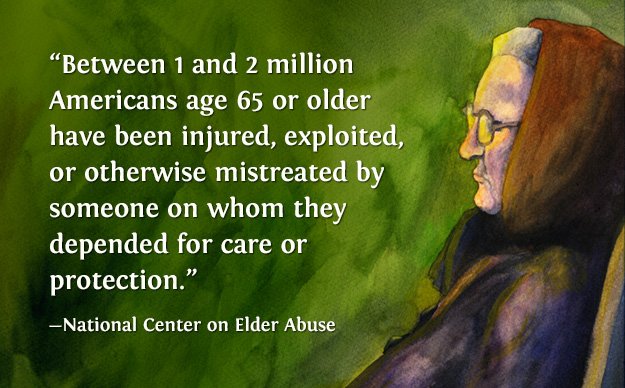Though many judges have seen elder abuse, not all may fully understand it. Often considered a “hidden” crime, elder abuse includes physical abuse, emotional abuse, verbal abuse, sexual abuse, financial exploitation, abandonment, neglect, and/or self-neglect. It can also be seen in civil, criminal, probate, family, and mental health proceedings, creating a variety of issues for the judicial system.
“The biggest challenge for the courts is identifying cases in which there is an underlying issue of elder abuse,” said Brenda Uekert, Principal Court Research Consultant for the National Center for State Courts. “Generally, narrowly crafted laws and charging decisions result in very few cases entering the court labeled as ‘elder abuse’ crimes. Consequently, the courts are often not aware of the extent of elder abuse and exploitation that may underlie a wide variety of cases heard in probate, family, criminal, and civil divisions.”
These challenges have been further complicated by the growing number of cases involving elder abuse. According to the National Center on Elder Abuse (2005), “between 1 and 2 million Americans age 65 or older have been injured, exploited, or otherwise mistreated by someone on whom they depended for care or protection.” This number is only expected to increase as the population aged 65 and older continues to grow.
According to a recent report commissioned by the United States Census Bureau (An Aging Nation: The Older Population in the United State, 2014), “in 2050, the population aged 65 and over is projected to be 83.7 million, almost double its estimated population of 43.1 million in 2012.” In Indiana alone, the number of persons aged 65 or older is expected to increase to over 729,600 individuals by 2030, representing a 64% increase since 2000.
To combat the growing number of cases involving elder abuse, Uekert urges courts to adopt best practices to help victims of elder abuse.
“As a starting point, we suggest courts modify our judicial benchcard for their jurisdiction to improve identification of and response to elder abuse,” said Uekert. “Additionally, education for judges and court staff is essential. The National Center for State Courts offers a free online course, entitled ‘Justice Responses to Elder Abuse’.”
Other judicial responses to elder abuse include establishing “Elder Courts”, or specialized dockets that hear all cases of physical, emotional, or financial abuse involving persons 65 year or older. In 2008, the nation’s first Elder Court was created in Contra Costa County, California to hear all cases involving elder abuse, restraining orders, felonies, misdemeanors, landlord-tenant disputes, probate matter, small claims, and other legal disputes (Center for Elders and Courts). The Elder Court further accommodates the needs of elders by scheduling hearings after 10 a.m. and accommodating for their physical needs by providing wheelchair assistance, assistive listening devices, and document readers for individuals who are visually impaired.
“Elder Justice Centers” have also developed in response to the on-going problem of elder abuse. In 1999, the first Elder Justice Center was opened in Hillsborough and Palm Beach Counties, Florida, to provide assistance to elders involved in guardianships, criminal, family, or other civil matters. As a result of this initiative, several social and legal service agencies currently provide assistance to older adults age 60 or older.
According to Uekert, “In larger jurisdictions, the creation of Elder Justice Centers and/or Elder Courts is a promising development. In smaller jurisdictions, a problem-solving approach that focuses on specific cases and includes collaborative efforts with local service providers offers the promise of providing substantive help to older adults impacted by abuse, neglect, or exploitation.”
In Indiana, the Supreme Court’s Division of State Court Administration (Division) was recently awarded a $339,000 federal grant through the Department of Justice’s Office on Violence Against Women for the Indiana Project on Abuse in Later Life (INPALL). The purpose of INPALL is to develop and enhance the delivery of services to victims of elder abuse in St. Joseph County, with the ultimate goal of replicating the lessons learned from INPALL elsewhere in the state.
In January 2015, the Division began working with the INPALL partners, including the St. Joseph County Prosecutor’s Office, the St. Joseph County Sheriff’s Department, the South Bend and Mishawaka Police Departments, the Family Justice Center of St. Joseph County, and REAL Services, Inc., on developing a targeted and effective community response to elder abuse.
Through INPALL and the recent development of the guardianship registry, the Division hopes to continue to raise awareness and work with judges on developing effective responses to the many challenges created by elder abuse throughout Indiana.
For more information on this article, please contact Erica Costello at (317) 234-5562 or [email protected].
Image @istock.com/h2o_color